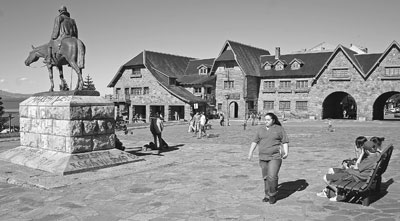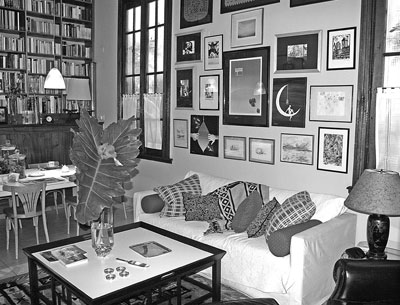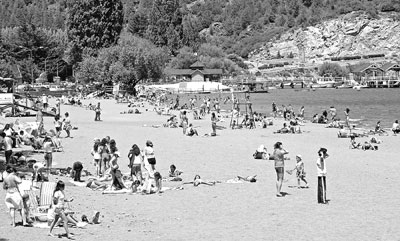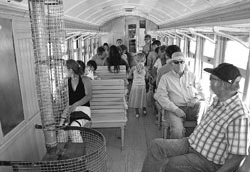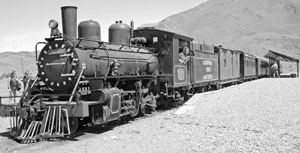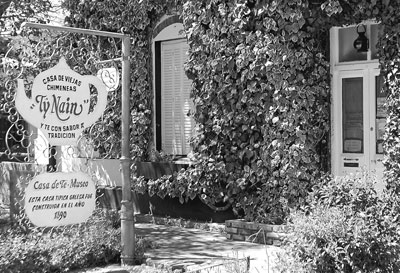Patagonia — on your own
by Jim Hendrickson, Bellingham, WA
Armed with a frequent-flyer ticket, a Lonely Planet guidebook and a good knowledge of Spanish, I decided to escape the wet Pacific Northwest winter by heading south to sunny Argentina in January ’06. I had been to Argentina twice before, but I had seen little of its immense region called Patagonia.
Buenos Aires beginning
My 5-week solo journey began in Buenos Aires, where I stayed at a small guest house called Mi Casa en San Telmo (Chacabuco 764, Departamento 18; phone 005411 4300 8583, www.micasaensantelmo.com.ar). I booked my single bedroom with breakfast over the Internet at $18 per night.
I spent several days wandering the narrow cobbled streets of San Telmo, one of Buenos Aires’ most historical barrios. At an outdoor café in the famous Plaza Dorrego, I enjoyed a delicious lunch consisting of a chicken-stuffed empanada, a large chef’s salad and a milkshake for only $4 including the tip. The 85-degree temperature and the favorable exchange rate of the Argentine peso (about three pesos for one U.S. dollar) also were agreeable to me.
Bariloche
I took a first-class bus from Buenos Aires’ enormous Retiro bus station across vast flatlands to Bariloche, a city located 1,000 miles away in the Lake District, a subregion of Patagonia. The 20-hour ride, which included a very roomy seat that inclined into a flat bed, plus videos and meals and snacks served by a steward, cost only $56. I was in frugal heaven!
Because it was summer and high season, Bariloche was overrun with tourists, especially young backpackers. Nevertheless, with the wonderful assistance of the folks at the municipal tourist office, I found a clean but somewhat noisy room with breakfast for $26 a night at Hostería Pudú Pudú (20 de Febrero 549; phone 02944 437665, e-mail pudu_pudu@ciudad.com.ar).
Bariloche served as my base for exploring the beautiful Lake District. In my small backpack I carried a water bottle, several sandwiches and a few chocolate bars. (Bariloche is the chocolate capital of Argentina.)
Several times I visited nearby Nahuel Huapi National Park, where I took long hikes and a pleasant boat trip around the lake. I especially enjoyed strolling around the grounds of the state-built Hotel Llao Llao, whose daily room rates were eons above my $50-per-day budget (including all of my expenses).
I also spent a day hiking around Pampa Linda, an area resembling California’s Yosemite Valley. Located about 2½ hours from Bariloche by bus ($5 each way), Pampa Linda has dozens of waterfalls that plunge over the flanks of extinct volcanoes. Entrance to the park cost $4.
During these day trips, I met many friendly Argentines on vacation. Often they invited me to join them — on hikes, on a boat excursion and even to sample yerba maté, their national tea drink (a bitter, “acquired” taste). Although I speak Spanish, many people in Argentina do speak English quite well.
San Martín
From Bariloche I traveled north by bus to San Martín de los Andes, a fashionable mountain resort situated on a small bay on Lake Lácar. The only accommodation I could find there was a triple room with breakfast ($38 per night) at Hostería Parque Los Andes (Ruta Nacional 234 y Arroyo Trabunco; phone 02972 428211). This B&B is one of the oldest in town and has hosted royalty and other dignitaries, including the famous Chilean poet laureate, Pablo Neruda.
I took many pleasant walks along San Martín’s quiet tree-lined streets, past charming wooden homes and stores, and to several attractive lakeside beaches.
One of the highlights of my visit to the town was a full-day excursion by boat around Lake Lácar, including several guided hikes in Lanín National Park. There I saw extensive stands of raulí, a broadleaf, deciduous southern beech, and the curious pehuén, or monkey puzzle tree, a pine-like conifer whose nuts are a dietary staple for the local indigenous people, the Pehuenches and Mapuches.
Welsh influence
From San Martín I took a bus southward to the laid-back little town of El Bolsón, nestled in a fertile valley where most of Argentina’s hops are grown. A woman at the local tourist office helped me find a small apartment at Departamentos “Meline House” (Ruta 258; phone 02944 492481). The unit included a double bed, a bathroom and a kitchen with a fridge, cookware and utensils for $33 per night.
In town I attended a celebration held by the local Welsh community, whose costumed singers sang in Spanish and Welsh. I also stuffed myself with natural and vegetarian foods purchased in the farmers’ market and took buses to the nearby hills and Lake Puelo National Park, where I hiked and took many photographs.
Another long-distance bus took me farther south to Esquel. After contacting at least 20 lodgings without success, I rented a noisy bedroom without breakfast at Hostería Huentru Niyeu (Chacabuco 606; phone 02945 452576) for $18 per night.
The highlight of my visit to Esquel was a ride on a narrow-gauge steam train called La Trochita, made world famous by Paul Theroux in his book “The Old Patagonian Express.” What a treat it was to board one of the 1922-vintage passenger cars, sit next to a woodstove (used in winter) and chug, clickety-clack, to the remote station of Nahuel Pan at an average speed of 20 miles per hour! With a senior discount, the round-trip fare for the 2½-hour excursion was less than $7.
For another $20 I bused 400 miles to the east, across the Patagonian pampas, to Trelew, named from the Welsh contraction of “tre” (town) and “lew” (after Lewis Jones, its founder). My $17-per-night room (with breakfast) was waiting for me at the historic Hotel Touring Club (Avenida Fontana 240; phone 02965 433997, e-mail htouring@speedy.com.ar). I was so inspired by its old-fashioned restaurant, with white-coated waiters, pressed-tin ceiling and 1920s bar, that I translated into English the history of the hotel that the amicable owner gave me. Now English readers will also be able to enjoy reading about its fascinating past.
By bus I visited the nearby Welsh village of Gaiman, founded in 1874. Here visitors can take an authentic high tea, complete with scones, prepared by owners of several teahouses. With the guidance of a free brochure from the tourist office, I took a walking tour of Gaiman and learned that a third of its residents claim Welsh ancestry.
Puerto Madryn
Next, I took a bus one hour north of Trelew to Puerto Madryn, set along the Atlantic Ocean. For $30 a night I rented a double room, including a private bath and breakfast, at Residencial Manolo’s (Avenida Roca 763; phone 02965 472390, e-mail manolos@speedy.com.ar).
Puerto Madryn’s main attraction is the Península Valdés wildlife preserve (entry, $12), home to sea lions, elephant seals, guanacos, rheas, Magellanic penguins and numerous seabirds. In 1999 it was named a UNESCO World Heritage Site.
I thoroughly enjoyed visiting the reserve. (My excursion by minibus, including pickup and dropoff at my accommodation, cost $38).
A modern, air-conditioned bus brought me full circle back to Buenos Aires, where I stayed at B&B Olleros 3000* (Olleros 3000; phone 54 [01] 11 4554-7269, www.olleros3000.com.ar).
I had stayed at this lovely B&B in December ’02, and it was wonderful to be welcomed again by its friendly owners, Claudine Hemelryk and her husband, Juan. My room ($35 per night) had a twin bed, a color TV, an air-conditioner and ample closet space. A generous breakfast was included in this price, along with access to an extensive library and a computer with Internet access.
How marvelous it was to chat with Claudine and Juan again and to share with them the many adventures I had experienced in unforgettable Patagonia. I shall return!
—Jim Hendrickson, Bellingham, WA
*[B&B Olleros 3000 has closed. See this item in the May 2014 Boarding Pass column. —Editor]


